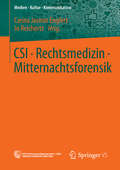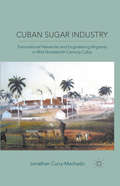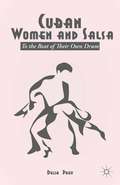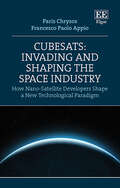- Table View
- List View
Cryptology and Network Security: 16th International Conference, Cans 2017, Hong Kong, China, November 30--december 2, 2017, Revised Selected Papers (Lecture Notes in Computer Science #11261)
by Srdjan Capkun Sherman S. ChowThis book contains revised versions of all the papers presented at the 16th International Conference on Cryptology and Network Security, CANS 2017, held in Hong Kong, China, in November/ December 2017. The 20 full papers presented together with 8 short papers were carefully reviewed and selected from 88 submissions. The full papers are organized in the following topical sections: foundation of applied cryptography; processing encrypted data; predicate encryption; credentials and authentication; web security; Bitcoin and blockchain; embedded system security; anonymous and virtual private networks; and wireless and physical layer security.
Cryptology and Network Security: 4th International Conference, CANS 2005, Xiamen, China, December 14-16, 2005, Proceedings (Lecture Notes in Computer Science #3810)
by Yvo G. Desmedt Huaxiong Wang Yi Mu Yongqing LiCryptology and Network Security: 7th International Conference, CANS 2008, Hong-Kong, China, December 2-4, 2008. Proceedings (Lecture Notes in Computer Science #5339)
by Matthew Franklin Lucas Chi-Kwong Hui Duncan S. WongThis book constitutes the refereed proceedings of the 7th International Conference on Cryptology and Network Security, CANS 2008, held in Hong-Kong, China, in December 2008. The 27 revised full papers presented were carefully reviewed and selected from 73 submissions. The papers are organized in topical sections on cryptosystems, signatures, identification, authentication and key management, cryptographic algorithms and protocols, stream ciphers and block ciphers, cryptographic foundations, applications and implementations, as well as security in ad hoc networks and wireless sensor networks.
Cryptology and Network Security: 5th International Conference, CANS 2006, Suzhou, China, December 8-10, 2006, Proceedings (Lecture Notes in Computer Science #4301)
by David Pointcheval Yi Mu Kefei ChenThis book constitutes the refereed proceedings of the 5th International Conference on Cryptology and Network Security, CANS 2006, held in Suzhou, China, December 2006. The 26 revised full papers and 2 invited papers cover encryption, authentication and signatures, proxy signatures, cryptanalysis, implementation, steganalysis and watermarking, boolean functions and stream ciphers, intrusion detection, and disponibility and reliability.
CSCW-Kompendium: Lehr- und Handbuch zum computerunterstützten kooperativen Arbeiten
by Gerhard Schwabe Norbert Streitz Rainer UnlandEffiziente, konstruktive und zielgerichtete kooperative Zusammenarbeit spielt in einer Zeit immer schnellerer Entwicklungszyklen die entscheidende Rolle im Kampf um Marktvorteile. Hier, wie auch in vielen anderen Arbeits- und Lebensbereichen, eröffnet der Einsatz von Informationstechnologie neue, faszinierende Perspektiven, die zu entscheidenden Veränderungen in der menschlichen Zusammenarbeit in Unternehmen und im Privatbereich geführt haben und noch führen werden. Dieses Buch liefert einen umfassenden, kompetenten und auch für den Nicht-Fachmann verständlichen Einblick in die Grundlagen, Methoden und Konzepte, die Werkzeuge und Anwendungen und die Potenziale, Wirkungen und Perspektiven computerunterstützter kooperativer Zusammenarbeit. Das von international anerkannten Autoren geschriebene Buch eignet sich als einführendes Lehrbuch für Studierende an Universitäten und FHs und als Handbuch für Entwickler und Praktiker.
CSI • Rechtsmedizin • Mitternachtsforensik (Medien • Kultur • Kommunikation)
by Carina Jasmin Englert Jo ReichertzDas Buch gibt einen Einblick in die Entwicklung eines Marktes in undum die deutsche Rechtsmedizin. Seit die Aufmerksamkeit der Medieneine Währung ist, konkurrieren auf diesem Markt unterschiedlicheAkteure miteinander. Diese Entwicklung geht auf Fernsehsendungen überVerbrechensaufklärung und Rechtsmedizin zurück und umfasst mehr alsden im US-amerikanischen Diskurs postulierten CSI-Effekt. Diesererklärt den Zusammenhang zwischen Fernsehsendungen wie _CSI: LasVegas_ und dem Verhalten von Geschworenen vor Gericht und demInteresse der Öffentlichkeit an Gerichtsmedizin. Dabei gerät aus demBlick, dass die Sendungen in ihren Darstellungen über die Wirkmachtrechtsmedizinischer Methoden nicht nur sehr unterschiedlich ausfallenkönnen, sondern dass auch die Folgen dieser medialen Darstellungenvielfältige gesellschaftliche Entwicklungen anstoßen.
CSR 2.0: Transforming Corporate Sustainability and Responsibility (SpringerBriefs in Business)
by Wayne VisserThe book examines the evolution and current state of corporate social responsibility (CSR), using a five-stage maturity model: defensive, charitable, promotional, strategic and transformative CSR. The first four stages are dubbed CSR 1.0 and characterise most current CSR practice, while the fifth stage is named CSR 2.0 (also transformative or systemic CSR) and describes emergent and future CSR practices. Reasons are given why CSR 1.0 approaches have failed to have any significant impact on the most serious global social, environmental and ethical challenges. The emergent CSR 2.0 will then be explored in detail by elaborating on five principles underlying the new approach, including: creativity, scalability, responsiveness, glocality and circularity. A four-part DNA Model is also introduced, covering value creation, good governance, societal contribution and ecological integrity, which provides the basis for defining and measuring CSR 2.0. Finally, a 70-question CSR 2.0 self-assessment diagnostic tool developed by the author is presented, with sample data to show how the tool can be used for future research and practitioner application.
CSR-Bildung: Corporate Social Responsibility als Bildungsaufgabe in Schule, Universität und Weiterbildung
by Fabiene Theis Simone KleinEine kluge Einsicht gewinnt an Bedeutung und setzt sich durch: Die Übernahme gesellschaftlicher Verantwortung und die Gestaltung guter Arbeit durch die Unternehmen selbst sind ein wirtschaftlicher Erfolgsfaktor. Viele Unternehmen in Deutschland handeln danach – freiwillig, über den gesetzlichen Rahmen hinaus und in Fortsetzung einer guten Tradition: Denn das Bewusstsein, dass wirtschaftliche Leistungsfähigkeit auf der einen und soziale und ökologische Verantwortung auf der anderen Seite keine Gegensätze sind, sondern sich gegenseitig bedingen, hat uns stark gemacht. „Corporate Social Responsibility“ (CSR) ist daher alles andere als ein Schönwetterthema. Unternehmensverantwortung ist eine Strategie, die sich gerade auch in Krisenzeiten für die Betriebe auszahlt, ganze Volkswirtschaften stärkt und der Gesellschaft insgesamt zugute kommt. Die Idee der „Unternehmensverantwortung“ ist nicht neu. Ein kluger - gang mit dieser Idee muss dennoch immer wieder neu erlernt werden. Je früher das geschieht, desto besser. Urteilskraft und Kritikfähigkeit sind Voraussetzung für selbstbestimmtes Handeln. Die Grundlage dafür ist Bildung. Ihre Aufgabe präzisiert Immanuel Kant in seiner Schrift „Über Pädagogik“ folgendermaßen: „Die praktische oder moralische [Pädagogik oder Erziehungslehre] ist d- jenige, durch die der Mensch soll gebildet werden, damit er wie ein frei h- delndes Wesen leben könne. (. . . ) Sie ist Erziehung zur Persönlichkeit, Erziehung eines frei handelnden Wesens, das sich selbst erhalten, und in der Gesellschaft ein Glied ausmachen, für sich selbst aber einen innern Wert haben kann.
CSR und Investment Banking: Investment und Banking zwischen Krise und Positive Impact (Management-Reihe Corporate Social Responsibility)
by Karen WendtDie Finanzindustrie ist Spiegel der Gesellschaft und ihr Businessmodell befindet sich nicht erst seit der Finanzkrise am Scheideweg. Wenn die Negativspirale aus Klimawandel, rasantem Bevölkerungswachstum, ungehemmter Urbanisierung und zunehmend sozialen Spannungen abgewendet werden soll, sind ganzheitliche Management-Ansätze zwingend. Immer mehr Vorstände und Experten der deutschen Finanzindustrie zeigen - nachhaltiges Investment und nachhaltiges Bankgeschäft ist machbar. Vordenker aus Wirtschaft, Wissenschaft und Gesellschaft stellen die integrierte Betrachtung finanzieller, gesellschaftlicher und Umweltleistung in den Mittelpunkt der Geschäftsstrategie und zeigen, dass Integration von Nachhaltigkeit in die Wertschöpfungskette funktioniert. Das klassische Dreieck aus Profit, Risiko und Liquidität wird um eine vierte Komponente ergänzt, die gesellschaftliche Wirkkraft der Geldverwendung.
CSR und Wertecockpits: Mess- und Steuerungssysteme der Unternehmenskultur (Management-Reihe Corporate Social Responsibility #299)
by Friedrich GlaunerDieses Buch verknüpft betriebswirtschaftliche Ansätze zur Steuerung von Unternehmensprozessen mit interdisziplinären Forschungsergebnissen zu den Treiberkräften menschlichen Denkens und institutionellen Handelns. Das Resultat, der Wertecockpit, zeigt, dass die Steuerung der Wertekultur ein Wertschöpfungsprozess ist, der die Grundlage für alle anderen Unternehmensprozesse bildet und über die Zukunftsfähigkeit von Unternehmen entscheidet.
CSR und Wertecockpits: Mess- und Steuerungssysteme der Unternehmenskultur (Management-Reihe Corporate Social Responsibility)
by Friedrich GlaunerUnternehmenswerte sichern den Unternehmenserfolg.Das Wertecockpit steuert sie transparent und nachhaltig ertragssteigernd.Unternehmenswerte beeinflussen messbar den wirtschaftlichen Erfolg herausragender Unternehmen. Das Instrument des Wertecockpits gestaltet die Werte transparent. Es verknüpft betriebswirtschaftliche Ansätze zur Steuerung von Unternehmensprozessen mit interdisziplinären Forschungsergebnissen zu den Treiberkräften menschlichen Denkens und Handelns.Das Buch erläutert, wie und warum die Unternehmenskultur, individuell und nach klaren Regeln operativ gelenkt, ein signifikantes Asset wirtschaftlichen Erfolgs ist. Es zeigt, dass die Steuerung der Wertekultur ein Wertschöpfungsprozess ist, der die Grundlage für alle anderen Unternehmensprozesse bildet. Mit den Instrumenten des Wertecockpits kann er in jedem Unternehmen effizient und schlank umgesetzt werden.In der Darstellung namhafter Unternehmen und Interviews mit ihren CEOs und Gründern wird die Frage beantwortet, auf welche Weise weiche Unternehmensfaktoren einen messbaren Beitrag zur dauerhaften Leistungsfähigkeit von Unternehmen leisten. Das Wertecockpit erfasst mit seinen integralen Instrumenten des C4-Managements und der sieben Treiberfaktoren der Unternehmenskultur alle Bereiche der strategischen und operativen Unternehmensführung.
CSR und Wirtschaftspsychologie: Psychologische Strategien zur Förderung nachhaltiger Managemententscheidungen und Lebensstile (Management-Reihe Corporate Social Responsibility)
by Irene LópezDieses Buch fokussiert auf die Ebenen der direkten Implementierung von Corporate Social Responsibility im Unternehmen und im Konsumverhalten. Nicht immer ist das Verständnis für CSR-Maßnahmen bei Mitarbeitern gegeben, doch gerade die Integration von nachhaltigen Strategien in das eigene Bewusstseins und damit das eigene Handeln ist erfolgsentscheidend. Dieses Herausgeberwerk präsentiert psychologische Erkenntnisse und Konzepte die in der Kommunikation mit den eigenen Mitarbeiter, aber auch mit Endverbrauchern, den Konsumenten, genutzt werden können. Spezialbeiträge von Beitragsautoren aus Wissenschaft und Praxis zeigen wie CSR und Wirtschaftspsychologe miteinander zu verknüpfen sind.
Cuban American Political Culture and Civic Organizing: Tocqueville in Miami
by Robert M. CeresaThis book studies civic organizations in Miami’s Cuban community. Few places in the United States have been transformed by immigration the way Miami has been transformed by Cuban exiles. Cuban civic organizations help to explain why this is the case. Civic organizations are the heart of the story of the social and political power and influence of Miami’s Cuban community. This community is home to a broad tradition of active political participation and many civic organizations. The sheer number of organizations suggests they have something to do with the community’s considerable vibrancy and civic capacity. How do the organizations work? How have they managed to be so successful over so many years? What can be learned about successful civic organizing from their experience? How will changing United States-Cuba relations impact Cuban civic organizations, and, in turn, broader Miami? These are questions this book helps to answer.
Cuban American Political Culture and Civic Organizing: Tocqueville in Miami
by Robert M. CeresaThis book studies civic organizations in Miami’s Cuban community. Few places in the United States have been transformed by immigration the way Miami has been transformed by Cuban exiles. Cuban civic organizations help to explain why this is the case. Civic organizations are the heart of the story of the social and political power and influence of Miami’s Cuban community. This community is home to a broad tradition of active political participation and many civic organizations. The sheer number of organizations suggests they have something to do with the community’s considerable vibrancy and civic capacity. How do the organizations work? How have they managed to be so successful over so many years? What can be learned about successful civic organizing from their experience? How will changing United States-Cuba relations impact Cuban civic organizations, and, in turn, broader Miami? These are questions this book helps to answer.
Cuban Medical Internationalism: Origins, Evolution, and Goals (Studies of the Americas)
by J. Kirk H. Michael ErismanWhile public health is important for revolutionary Cuba, providing medical services to the developing world is also a priority: 38,000 medical staff are engaged abroad; the largest medical school in the world (ELAM) has an enrollment of over 8,000 students from the Third World; and since 2004 over 1.3 million in Latin America and the Caribbean have had their eyesight restored. How has this small nation of 11.3 million people managed to save more lives in the developing world than all of the G-8 countries together? And what are its motives? This book, the result of four years of research in Cuba, provides an updated analysis of this extraordinary record.
The Cuban Revolution (1959-2009): Relations with Spain, the European Union, and the United States
by J. RoyFifty years after the triumph of the Cuban Revolution and the establishment of a Marxist-Leninist regime in Cuba, the two fundamental dimensions of this historical phenomenon are the survival of the system created by Fidel Castro and the policy of the United States to terminate it.
Cuban Sugar Industry: Transnational Networks and Engineering Migrants in Mid-Nineteenth Century Cuba
by J. Curry-MachadoNineteenth-century Cuba led the world in sugar manufacture and technological innovation was central to this. Through the story of a group of forgotten migrant workers who anonymously contributed to Cuba's development, this book explores the development of the Cuban sugar industry and how the country became bound into global networks.
Cuban Women and Salsa: To the Beat of Their Own Drum
by D. PoeySalsa is both an American and transnational phenomenon, however women in salsa have been neglected. To explore how female singers negotiate issues of gender, race, and nation through their performances, Poey engages with the ways they problematize the idea of the nation and facilitate their musical performances' movement across multiple borders.
CubeSats: The Impact of Nano-Satellite Innovators on Space Exploration
by Francesco P. Appio Paris ChrysosProviding a fascinating view into the creation of CubeSats, this book outlines their metamorphic role in democratizing space exploration. Paris Chrysos and Francesco Paolo Appio delve into the novel world of satellite innovation, showcasing how revolutionary CubeSats have been in shaping the future of space technology.CubeSats: Invading and Shaping the Space Industry investigates the crucial activities of CubeSat teams, detailing their interactive and intimate approach to satellite engineering. Chapters emphasize the important role of universities in offering autonomy and fresh perspectives in space exploration contexts, including interview extracts to provide the reader with first-hand detail of this visionary work. Ultimately, they highlight the increasing potential for CubeSats to carve their own niche within the space industry.This enlightening book will be invaluable for students and academics of technology and innovation management pursuing a better understanding of new satellite technology advancements. It will additionally be highly beneficial for researchers seeking a concise overview of CubeSat use and modification.
Cuckoo Land: The Cuckooing Risk Environment (Drugs, Crime and Society)
by Jack SpicerDrawing on rich qualitative data, this book presents a novel way of understanding the drug market-related harm of ‘cuckooing’, providing a theoretically informed account of this increasingly high-profile area.Applying the framework of the ‘risk environment’, the book examines why people become cuckooed, how it is responded to and how this exploitative practice is socially produced. In doing so, a diverse range of environments and features relevant to cuckooing are analysed, including the role of housing, political economy, drug policy, policing and social exclusion. By interrogating how these constrain and enable the actions of people who are affected, the book develops a critical analysis that recognises the complexity of cuckooing while eschewing superficial explanations of why it occurs. Resisting simplistic solutions, it also considers what an enabling environment capable of reducing the harms of this exploitative practice might look like.Cuckoo Land will be of interest to academic researchers in the fields of criminology, victimology, social work and drugs. It will also be essential reading for policymakers and practitioners working on the issue of cuckooing.
Cuckoo Land: The Cuckooing Risk Environment (Drugs, Crime and Society)
by Jack SpicerDrawing on rich qualitative data, this book presents a novel way of understanding the drug market-related harm of ‘cuckooing’, providing a theoretically informed account of this increasingly high-profile area.Applying the framework of the ‘risk environment’, the book examines why people become cuckooed, how it is responded to and how this exploitative practice is socially produced. In doing so, a diverse range of environments and features relevant to cuckooing are analysed, including the role of housing, political economy, drug policy, policing and social exclusion. By interrogating how these constrain and enable the actions of people who are affected, the book develops a critical analysis that recognises the complexity of cuckooing while eschewing superficial explanations of why it occurs. Resisting simplistic solutions, it also considers what an enabling environment capable of reducing the harms of this exploitative practice might look like.Cuckoo Land will be of interest to academic researchers in the fields of criminology, victimology, social work and drugs. It will also be essential reading for policymakers and practitioners working on the issue of cuckooing.
Cues: Master the Secret Language of Charismatic Communication
by Vanessa Van EdwardsIt's not enough to have great ideas. You also need to know how to communicate them.What makes someone charismatic? Why do some people captivate a room, while others have trouble managing a small meeting? What makes some ideas spread, while other good ones fall by the wayside? Cues - the tiny signals we send to others 24/7 through our body language, facial expressions, word choices and vocal inflection - have a massive impact on how we, and our ideas, come across. Our cues can either enhance our message or undermine it.In this entertaining and accessible guide to the hidden language of cues, Vanessa Van Edwards teaches you how to convey power, trust, leadership, likability and charisma in every interaction. You'll learn: - Which vocal cues make you sound more confident- Which body language cues assert, 'I'm a leader, and here's why you should join me'- Which verbal cues to use in pitches, branding and emails to increase trust (and generate excitement about interacting with you)- Which visual cues you are sending in your profile pictures, clothing and professional brandWhether you're pitching an investment, negotiating a job offer or having a tough conversation with a colleague, Cues can help you improve your relationships, express empathy and create meaningful connections with lasting impact.'Packed with invaluable strategies for maximizing your message, Van Edward's energy will inspire you to become the best possible version of yourself' - Nir Eyal, author of Hooked.'A must-have guide to becoming an unstoppable force' - Mel Robbins
Culinary Capital
by Peter Naccarato Kathleen LebescoTV cookery shows hosted by celebrity chefs. Meal prep kitchens. Online grocers and restaurant review sites. Competitive eating contests, carnivals and fairs, and junk food websites and blogs. What do all of them have in common? According to authors Kathleen LeBesco and Peter Naccarato, they each serve as productive sites for understanding the role of culinary capital in shaping individual and group identities in contemporary culture.Beyond providing sustenance, food and food practices play an important social role, offering status to individuals who conform to their culture's culinary norms and expectations while also providing a means of resisting them. Culinary Capital analyzes this phenomenon in action across the landscape of contemporary culture. The authors examine how each of the sites listed above promises viewers and consumers status through the acquisition of culinary capital and, as they do so, intersect with a range of cultural values and ideologies, particularly those of gender and economic class.
Culling the Masses: The Democratic Origins Of Racist Immigration Policy In The Americas
by David Scott FitzGeraldCulling the Masses questions the view that democracy and racism cannot coexist. Based on records from 22 countries 1790-2010, it offers a history of the rise and fall of racial selection in the Western Hemisphere, showing that democracies were first to select immigrants by race, and undemocratic states first to outlaw discrimination.
Culling the Masses: The Democratic Origins Of Racist Immigration Policy In The Americas
by David Scott FitzGeraldCulling the Masses questions the view that democracy and racism cannot coexist. Based on records from 22 countries 1790-2010, it offers a history of the rise and fall of racial selection in the Western Hemisphere, showing that democracies were first to select immigrants by race, and undemocratic states first to outlaw discrimination.






















